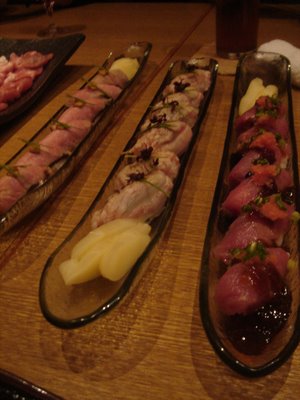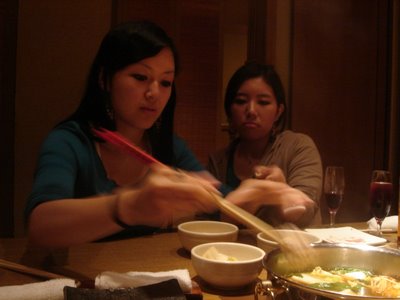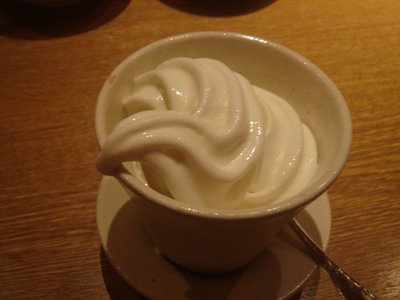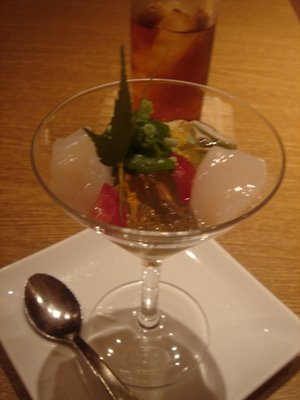Inokuya turned out to be a really modern, upscale restaurant located in one of the swank skyscrapers of Roppongi. The restaurant specializes solely in pork dishes, hence its name “Inokuya” which roughly translates to “little pig” in English (or so I am told). On our way to our table, we passed by the kitchen and from what I saw, I already knew I was in for a great meal. It was nice too because we got seated in our own private room, which was quiet and dimly light, making for a really intimate environment.
Being from the States, I’m accustomed to having an appetizer, main, and dessert comprise most meals, which is why the multi-course, tasting menu style at Inokuya was a real treat.

The meal started off with this cold appetizer dish - a piece of chilled tofu, topped with some pickled okra slices and wasabi, on top of a briny gelee. It was clean and refreshing.

Next came this salad dish, which was dressed lightly in a simple vinagrette and topped with some slices of really fatty pork. I’m not sure what kind of cut it was, but it seemed almost like cured bacon to me. Overall, it was a nice dish but the pork was a little too chewy for my liking, and I would have preferred it if the meat were leaner.

This dish, some snow peas with a green tea infused mayonnaise, was really creative I thought. It was crisp and light, which is exactly what you want in a palate cleanser.
Served in this martini glass were more cold ingredients. The sweetness of the raw scallops and grape tomatos balanced out the sharpness of the pungent, acidic gelee. I personally liked the dish, but Bryan, Lisa’s boyfriend, later told me he hated this and had a hard time keeping it down. I thought that was kind of funny.


The next course was pork ribs with three different kinds of preparation – salt and pepper, herb butter, and chili tomato. I got to try all three and my favorite was the herb butter. The meat was really tender and the flavors were great.
 Our waiter came by with this whole roast pork and carved us each a piece. This was definitely one of my favorites of the night. The seasoning was simple, but it really accentuated the meat and let the natural pork flavor come through. It was also cooked on the rare side to keep the meat moist and tender.
Our waiter came by with this whole roast pork and carved us each a piece. This was definitely one of my favorites of the night. The seasoning was simple, but it really accentuated the meat and let the natural pork flavor come through. It was also cooked on the rare side to keep the meat moist and tender.

 Now, I know what you’re thinking. Consuming raw pork is dangerous and pretty nasty. Well, you’re wrong! I thought the exact same thing, which is why when Sarah first mentioned pork sushi, the idea of pork sashimi never crossed my mind. Normally, I won’t eat raw pork, but if there is one place where I will, it’s Japan. Japan’s health and safety standards when it comes to food are extremely high. We were served three kinds of sushi – one completely raw with a soy glaze, one slightly charred, and one lightly roasted. They were all surprisingly delicious. I’d say take my word for it but I know you won’t, so it’s something you’ll have to try on your own.
Now, I know what you’re thinking. Consuming raw pork is dangerous and pretty nasty. Well, you’re wrong! I thought the exact same thing, which is why when Sarah first mentioned pork sushi, the idea of pork sashimi never crossed my mind. Normally, I won’t eat raw pork, but if there is one place where I will, it’s Japan. Japan’s health and safety standards when it comes to food are extremely high. We were served three kinds of sushi – one completely raw with a soy glaze, one slightly charred, and one lightly roasted. They were all surprisingly delicious. I’d say take my word for it but I know you won’t, so it’s something you’ll have to try on your own.


We had a little time to chill out and digest before the next course – pork shabu shabu. We ordered two platters of meat for six people, so to say that there was a lot of food is even an understatement. As usual, some vegetables were supplied to flavor the broth, which was slightly spicy and resembled kim-chi in flavor.
 By this time, I was completely stuffed, but there’s always room for dessert, right? We finished the marathon meal with this soft-serve ice-cream. It doesn’t look like anything out of the ordinary, but it was actually really good. The cream used is from Hokkaido where the good stuff is from!
By this time, I was completely stuffed, but there’s always room for dessert, right? We finished the marathon meal with this soft-serve ice-cream. It doesn’t look like anything out of the ordinary, but it was actually really good. The cream used is from Hokkaido where the good stuff is from!
Overall, I thoroughly enjoyed the meal. It was definitely one of the highlights of my trip. I love pork in general, so to dine at a restaurant specializing in pork was a huge treat. I can’t stress enough how thankful I am to the Miyake family because they really did spoil me. Inokuya was one of the many memorable dining experiences in Japan, and I still have quite a few entries left, so stay tuned!










